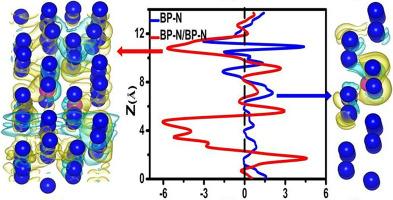利用 DFT 方法揭示掺杂非金属的黑色磷烯在储能应用中的量子电容
IF 8.3
2区 材料科学
Q1 MATERIALS SCIENCE, MULTIDISCIPLINARY
引用次数: 0
摘要
超级电容器作为一种储能设备,在消除能源资源方面发挥着举足轻重的作用。黑磷烯(BP)因其优异的性能,包括出色的载流子迁移率和独特的电子特性,被高度评价为超级电容器(SC)的潜在电极。在这项研究工作中,利用 DFT 研究了单层 BP 和双层 BP(BP/BP)结构。此外,还研究了在单层和双层中掺杂和共掺杂非金属(氧、氮)的影响,以通过调节 BP 的电荷存储和电子特性来提高其性能。研究了单层和双层的结构特性、状态密度、量子电容、表面电荷密度、巴德电荷分析、等表面电荷密度差、综合电荷密度。密度泛函理论(DFT)用于计算上述所有特性。双电层的所有计算都使用了带有贝克-约翰逊阻尼函数的 DFT-D3 方法作为分散校正因子。计算结果发现,与单层结构相比,双层结构的结果更好。这项工作的结果还显示,氧原子和氮原子的掺杂大大提高了单层和双层结构的 CQ 和 Q 值。在水体系中,除 BP/BP 双层结构外,所有复合材料都表现出不对称行为。BP-N/BP-N(1369.8µC/cm2)和 BP-O/BP-O (-1298.1µC/cm2)双层结构最适合作为阳极和阴极材料。在离子/有机体系中,所有复合材料都表现出不对称行为。BP-O/BP-O(-6053.5µC/cm2)和 BP-N/BP-N (9329.8µC/cm2)双层结构是最佳的阴极和阳极材料。本文章由计算机程序翻译,如有差异,请以英文原文为准。

Unraveling quantum capacitance of black phosphorene by the doping of non-metals for energy storage applications using DFT method
Supercapacitor plays a pivotal role as energy storage devices in the context of eliminating energy resources. Black Phosphorene (BP) is highly regarded as a potential electrode for supercapacitor (SC) because of its outstanding properties, including excellent carrier mobility and unique electronic properties. In this research work, the monolayer of BP and bilayer of BP (BP/BP) structure is investigated by using DFT. Moreover, the effect of doping and co-doping of non-metal (oxygen, nitrogen) in the mono- and bi-layer was also investigated to increase their performance by modulating the charge storage, and electronic properties of BP. The structural properties, density of states, quantum capacitance, surface charge density, bader charge analysis, isosurface charge density difference, integrated charge density of monolayer and bilayer are studied. The density functional theory (DFT) is used to calculate all above mention properties. DFT-D3 method with Becke-Johnson damping function is used as dispersion correction factor for all the calculations of bilayer. The calculated results find that bilayer structure gives better results as compared to monolayer structure. In this work, results also revealed that doping of oxygen and nitrogen atom significantly enhance the CQ and Q of mono- and bi-layer structure. For aqueous system, all the composites exhibited asymmetrical behavior except BP/BP bilayer. BP-N/BP-N (1369.8µC/cm2), and BP-O/BP-O (-1298.1µC/cm2) bilayer structure are best for anode and cathode material. In case of ionic/organic system, all composites showed asymmetrical behavior. BP-O/BP-O (-6053.5µC/cm2), and BP-N/BP-N (9329.8µC/cm2) bilayer structure is best cathode and anode material.
求助全文
通过发布文献求助,成功后即可免费获取论文全文。
去求助
来源期刊

ACS Applied Materials & Interfaces
工程技术-材料科学:综合
CiteScore
16.00
自引率
6.30%
发文量
4978
审稿时长
1.8 months
期刊介绍:
ACS Applied Materials & Interfaces is a leading interdisciplinary journal that brings together chemists, engineers, physicists, and biologists to explore the development and utilization of newly-discovered materials and interfacial processes for specific applications. Our journal has experienced remarkable growth since its establishment in 2009, both in terms of the number of articles published and the impact of the research showcased. We are proud to foster a truly global community, with the majority of published articles originating from outside the United States, reflecting the rapid growth of applied research worldwide.
 求助内容:
求助内容: 应助结果提醒方式:
应助结果提醒方式:


